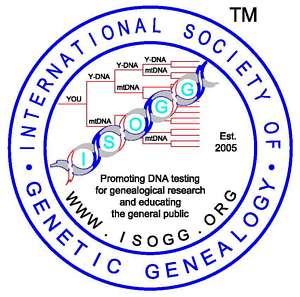The first phylogenetic chart to unify nomenclature was
published in 2002 by the
Y Chromosome Consortium (YCC). The 2003 Y-DNA phylogenetic chart
appeared in Mark A. Jobling and Chris Tyler-Smith,
The Human Y Chromosome: An Evolutionary Marker Comes of Age Nature Reviews|Genetics, Figure 5.
Family Tree DNA created the
2005 Y-Chromosome Phylogenetic Tree. Richard R. Kenyon formatted a
Y-DNA phylogenetic tree to an indented list.
An ISOGG group was formed in November 2005 to create a web-based document which could be
updated to keep pace with the rapid developments in the field. Current members are: Coordinator: Alice Fairhurst.
Design team: Bill Bailey, Katherine Hope Borges, Richard Kenyon,
Sasson Margaliot, Doug McDonald. Content experts: Whit Athey, Phil Goff, Gareth Henson,
Mike N. Humphrey, John McEwan, Ana Oquendo Pabon, Bonnie Schrack, Ann Turner, David Wilson.
Content experts liaison with experts from various
DNA labs to determine what information is needed to amend the tree.
The Y Haplogroup classification of the male
Y-chromosome is currently used to estimate the
population group of the paternal line. The haplogroups are identified by the letters, A through R.
Haplogroups are subdivided into one or more levels, called subclades, and thus forming a tree.
The Y-chromosome haplogroup is determined by performing a sequence of SNP tests.
Each line lists a haplogroup or subclade in boldface,
then one or more SNPs follow on the same
line. For a sample to belong to a particular subclade, it must test positive for any one of the
SNPs appearing on the line, providing positive results were obtained for its haplogroup and any
intervening subclades.
SNPs development indicated by beginning letters:
M = Peter Underhill, Ph.D. of Stanford University
N = The Laboratory of Bioinformatics, Institute of Biophysics, Chinese Academy of Sciences, Beijing
P = Michael Hammer, Ph.D. of University of Arizona
PK = Biomedical and Genetic Engineering Laboratories, Islamabad, Pakistan
S = James F. Wilson, D.Phil. at Edinburgh University
U = Lynn M. Sims, University of Central Florida; Dennis Garvey, Ph.D. Gonzaga University; and Jack
Ballantyne, Ph.D., University of Central Florida
V = Rosaria Scozzari and Fulvio Cruciani, Universit� "La Sapienza", Rome, Italy

